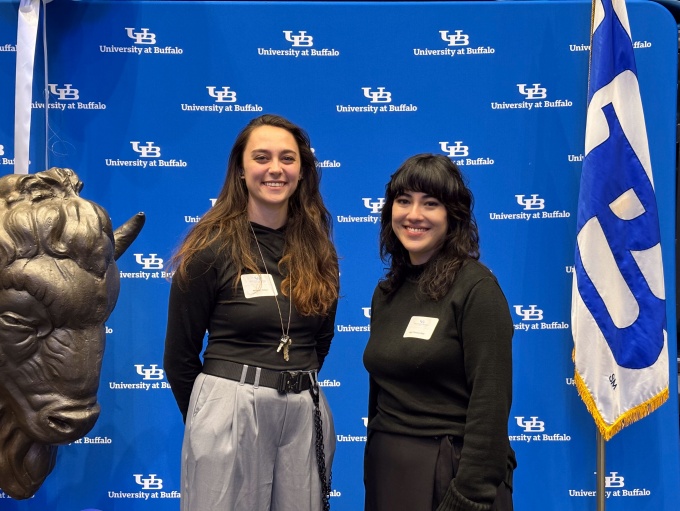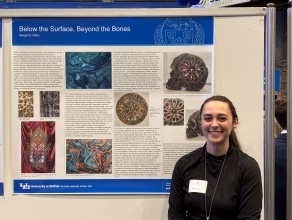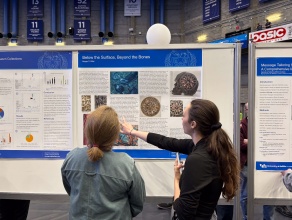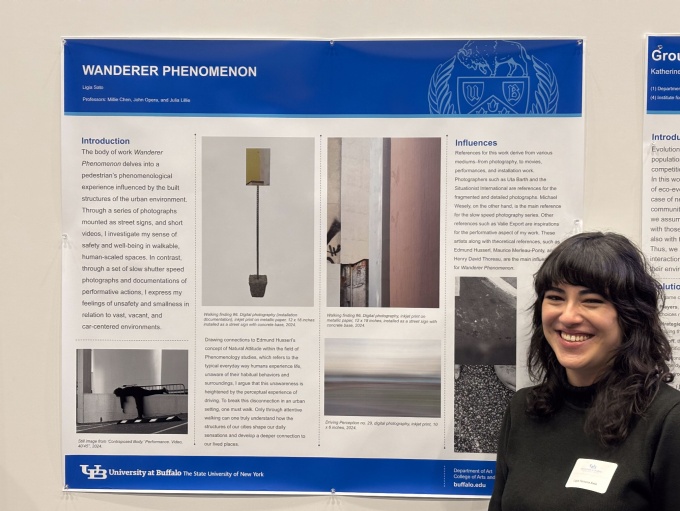Published May 1, 2025
MFA Candidates Killian and Sato recognized in Celebration of Academic Excellence
For their MFA thesis projects, students Meagan Killian and Ligia Sato were recognized at the University at Buffalo's 2025 Celebration of Student Academic Excellence, Wednesday, April 30th, in Alumni Arena.
Meagan Killian (left) and Ligia Sato (right) at the Celebration of Student Academic Excellence.
BELOW THE SURFACE, BEYOND THE BONES
Meagan Killian
My work focuses on the intersections of the human body and cathedral architecture. Iron, stone, glass, timber, bones, cartilage, tendons, and ligaments; are structural systems that provide stability and determine how the structure responds to external forces and internal stressors. By thinking of the body in this manner, where the skin is the surface of the cathedral and its openings as the conjoining of the inside and outside, I can weave together a motif in which we can enter into the body beyond our physical limits. Bringing in aspects of architectural lineage I explore the influences of familial genes to the individuals understanding and perception of our own bodies. |Working with acrylic paints I can manipulate perception and spatial orientation within the works and create tenuous moments of overlap between the conscious and subconscious mind, the circulatory system, and the skeletal system. By working with layered wood cutouts I can create physical spaces that combine both the body and cathedral inviting the viewer in and allowing for a space of reflection on the everyday inner workings of the body that are often overlooked. Through the use of a variety of media, my objective is to create moments of a symbiotic relationship between the structures of the body and elements taken from the architecture of Gothic cathedrals. Drawing inspiration from the surrealists movement I Strive to defy the conscious understanding of the traditional rigid and structural forms associated with cathedrals. While they still evoke the associated understanding of strength, their loose and unusually twisted forms bring forth the idea of fragility and a defiance of normalcy. The lack of traditional representation of objects and the interconnected quality of the compositions create a sense of timelessness where the viewer can enter a realm beyond reality.
WANDERER PHENOMENON
Ligia Teixeira Sato
Drawing connections to Edmund Husserl's concept of Natural Attitude within the field of Phenomenology studies, which refers to the typical everyday way humans experience life as being unaware of their habitual behaviors and surroundings, I argue that this unawareness is heightened by the perceptual experience of driving. To break this disconnection in an urban setting, one must walk. The body of artwork in Wanderer Phenomenon delves into a pedestrian's phenomenological experience as influenced by the built structures of the urban environment. Through a series of photographs mounted as street signs, and a series of short videos, I investigate my sense of safety and well-being in walkable, human-scaled spaces. In contrast, through a set of slow shutter speed photographs and documentations of performative actions, I express my feelings of unsafety and smallness in relation to vast, vacant, and car-centered environments.




